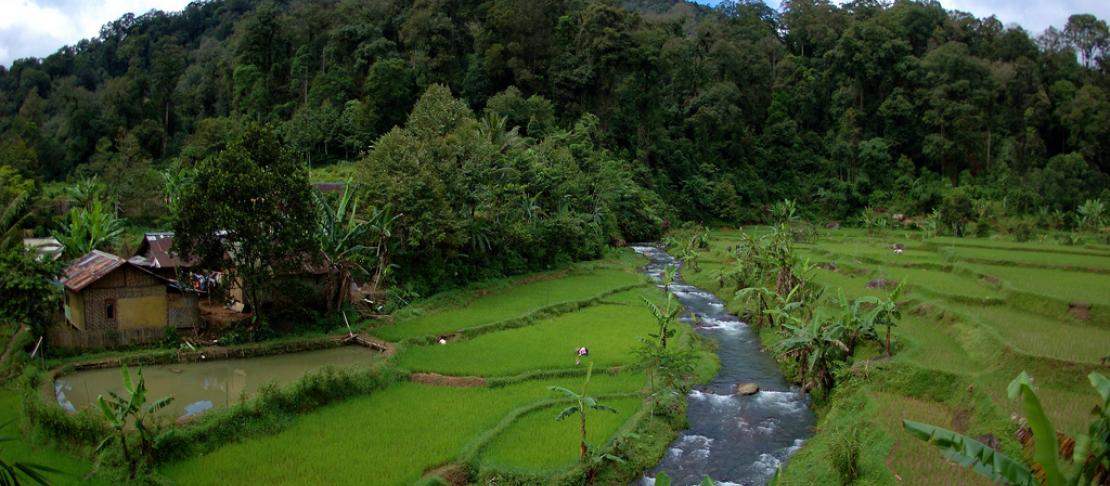Can climate-smart agriculture and forests work together at the landscape level?

The recent climate report from the Intergovernmental Panel on Climate Change (IPCC) warns that climate change will have a catastrophic impact on food production. This will change the face of world agriculture, as temperatures rise, rainfall patterns and amounts change and pests and diseases find new ranges.
Until recently, agriculture has tended to be on the sidelines of discussions on climate change. There is now, however, a growing recognition that agriculture and forests have big roles to play in adapting to climate change, including increasing resilience of livelihoods, improving nutrition and providing vital ecosystem services.
The Food and Agriculture Organization of the United Nations (FAO) defines climate-smart agriculture as consisting of three main pillars:
- Sustainably increasing agricultural productivity and incomes (food security);
- Adapting and building resilience to climate change (adaptation); and
- Reducing and/or removing greenhouse gases emissions (mitigation), where possible.
They also offer major opportunities for mitigating climate change, both reducing emissions and increasing sequestration of carbon. This is where ‘climate-smart agriculture’ comes in.
But while there are, no doubt, important synergies between climate-change adaptation and mitigation, there are also many challenges and trade-offs.
Farms and forests are often interwoven in complex landscapes, especially in smallholder systems in developing countries, and thus need to be managed in an integrated manner. This poses numerous challenges, not the least of which is the high transaction costs of dealing with large numbers of stakeholders.
In addition, expanding the land for crop and livestock production is the major driver of deforestation globally, leading to trade-offs as the products and ecosystem services of forests are lost.
The CGIAR Research Program on Climate Change, Agriculture and Food Security (CCAFS) and the Technical Center for Agricultural and Rural Cooperation (CTA) are co-organizing a sub-plenary session at the Global Landscapes Forum, starting 11:00-12:30, to look at what we need to do to make climate-smart agriculture’s uphold the three-fold promises made. Together with CTA, we have also launched a new booklet on climate-smart agriculture, Climate-Smart agriculture – Success stories from farming communities around the world, which will be discussed further at the sub-plenary.
Learn more: Climate-smart agriculture is improving the lives of millions - here's how
Moderated by CCAFS Director Dr. Bruce Campbell, the Director General of CATIE José Campos will examine how to ensure climate-smart agriculture is forest smart. Dorcas Robinson from Care International will discuss how to balance food security, adaptation and mitigation. In addition, the panelists will explore what role there is for a landscape approach within CSA to foster success.
Andy Jarvis, leading CCAFS theme on Long-term Adaptation, will be presenting some of technical and institutional innovations needed to boost uptake of climate-smart agriculture and spread its benefits.
“First, countries need to build analytical capacity and the evidence base to understand the impacts of climate change on agricultural growth strategies and food security, and identify climate smart options,” he said.
This means collecting more and better data on what is happening under different agricultural and forest systems, and having the analytical capacity to identify the best options under different social contexts.
“Second, we need to make a concerted effort work out why farmers are not adopting climate-smart agriculture,” Jarvis continued. “Many climate-smart agricultural practices have been shown to work, and work well, at pilot scale – just look at the all the success stories in the booklet we are putting out with CTA. But they are not spreading as fast as we would like. Why not? What is stopping farmers from adopting these practices?”
Which leads into the third and fourth issues Jarvis and his colleagues have identified as needing to be addressed: enabling policy and regulatory frameworks, and additional and better-targeted financing.
“Changing agricultural practices to adapt to and mitigate climate change requires a lot of up-front investment,” Jarvis noted. Currently, there’s too little public-sector funding available, and funding sources targeted at climate-change mitigation are generally not suited to individual small-scale farmers. But things are looking up. The Green Climate Fund, for example, could help bridge this gap:
“With the right practices and policies, the agricultural sector can decrease food insecurity and poverty, and can go from being part of the problem to being a major part of the solution to climate change,” said Jarvis concluded. “But if we are going to achieve this, we are going to need more investment in boosting farmers’ productivity, building national-level adaptive capacity and efforts to mitigate climate change.”
Read more: Closing the distance from the Green Climate Fund to farmers in Ghana
Paul Neate works a freelance science writer.
The CCAFS team is reporting live from the UNFCCC climate talks in Warsaw, 11-22 November 2013. Click to read all of our coverage. For live updates from the Climate talks in Warsaw, follow us on twitter @cgiarclimate and @bcampbell_CGIAR. Join the conversation using #GLFCOP19.



